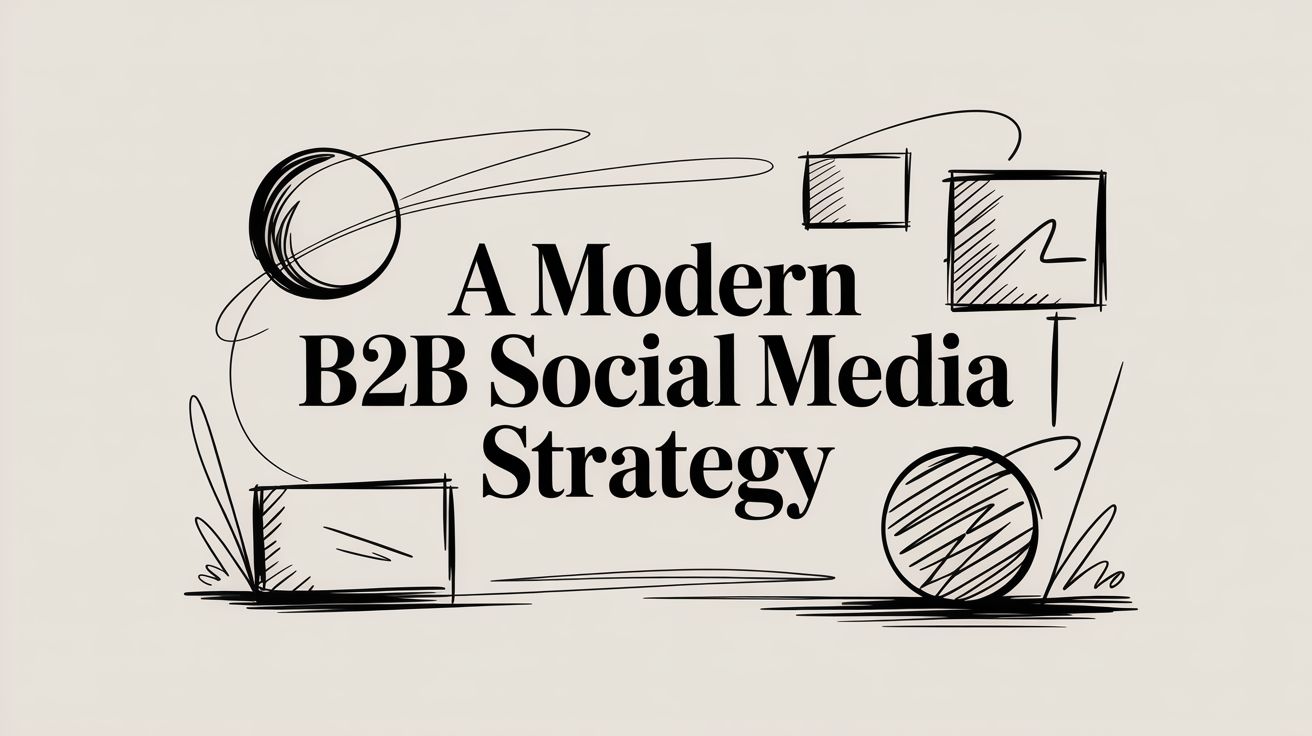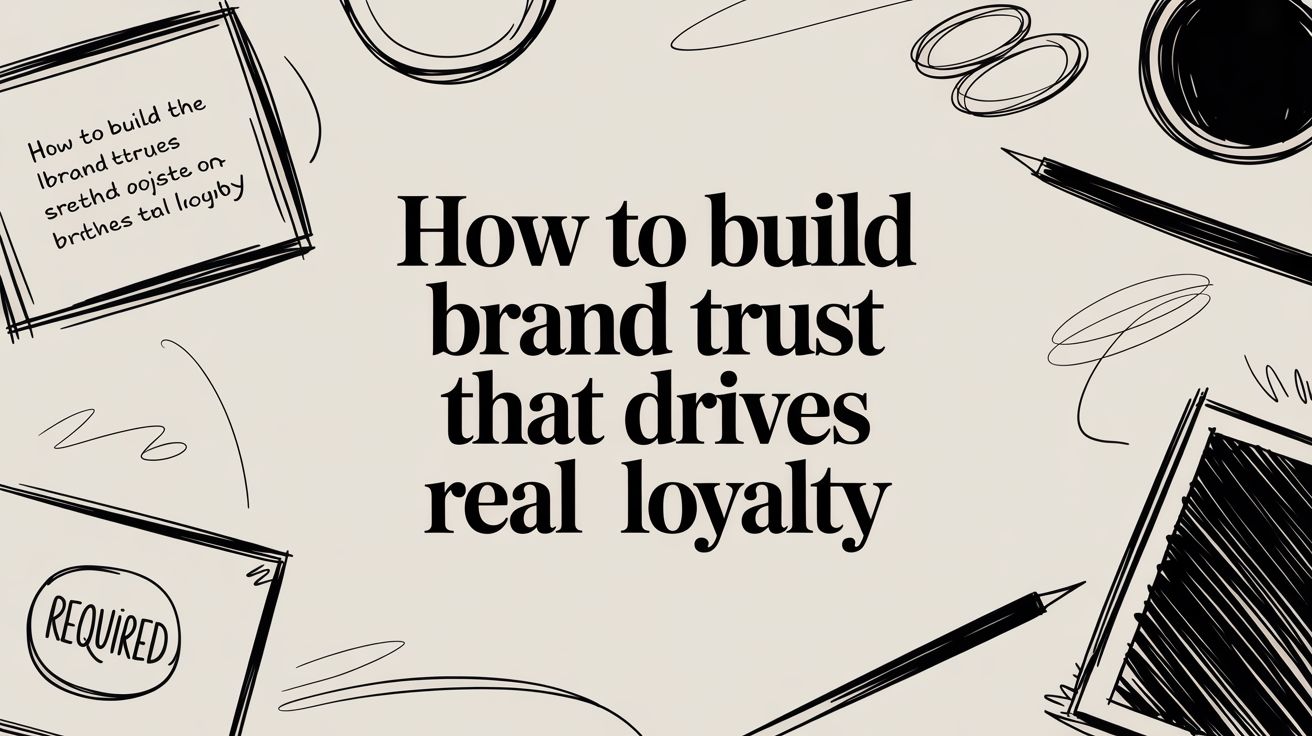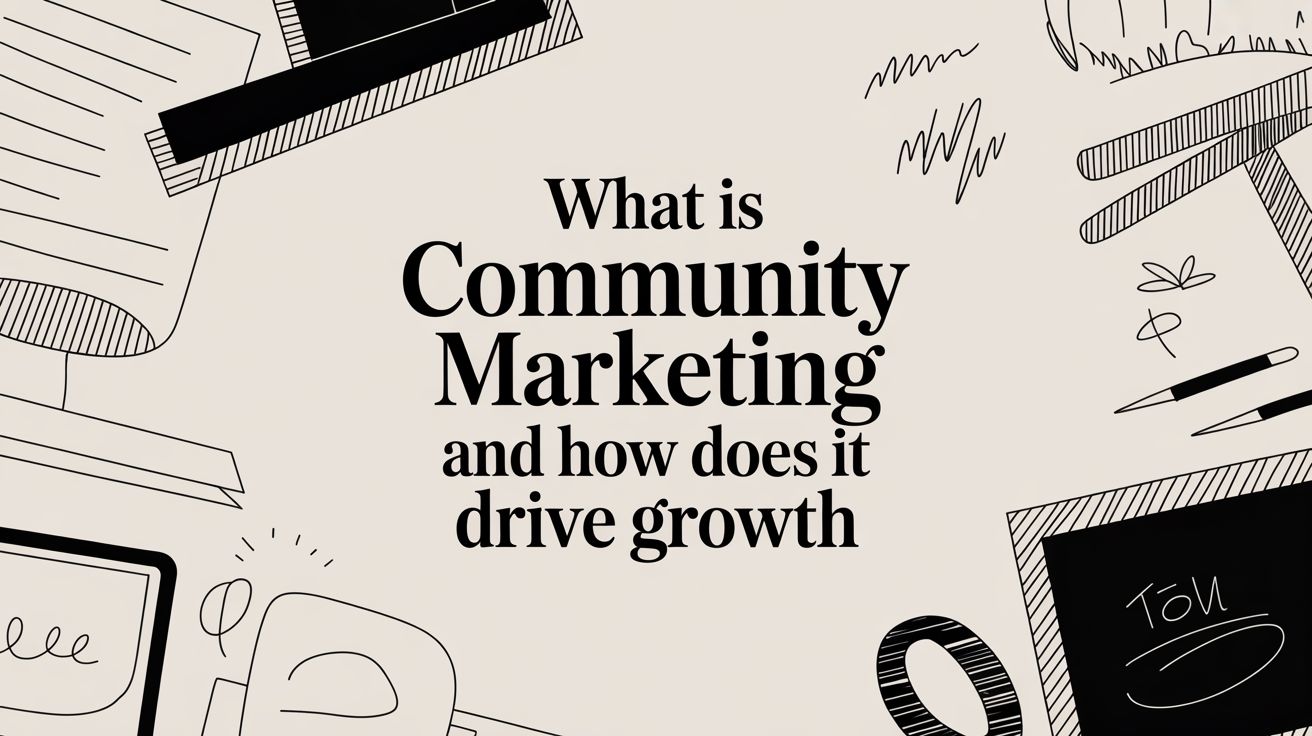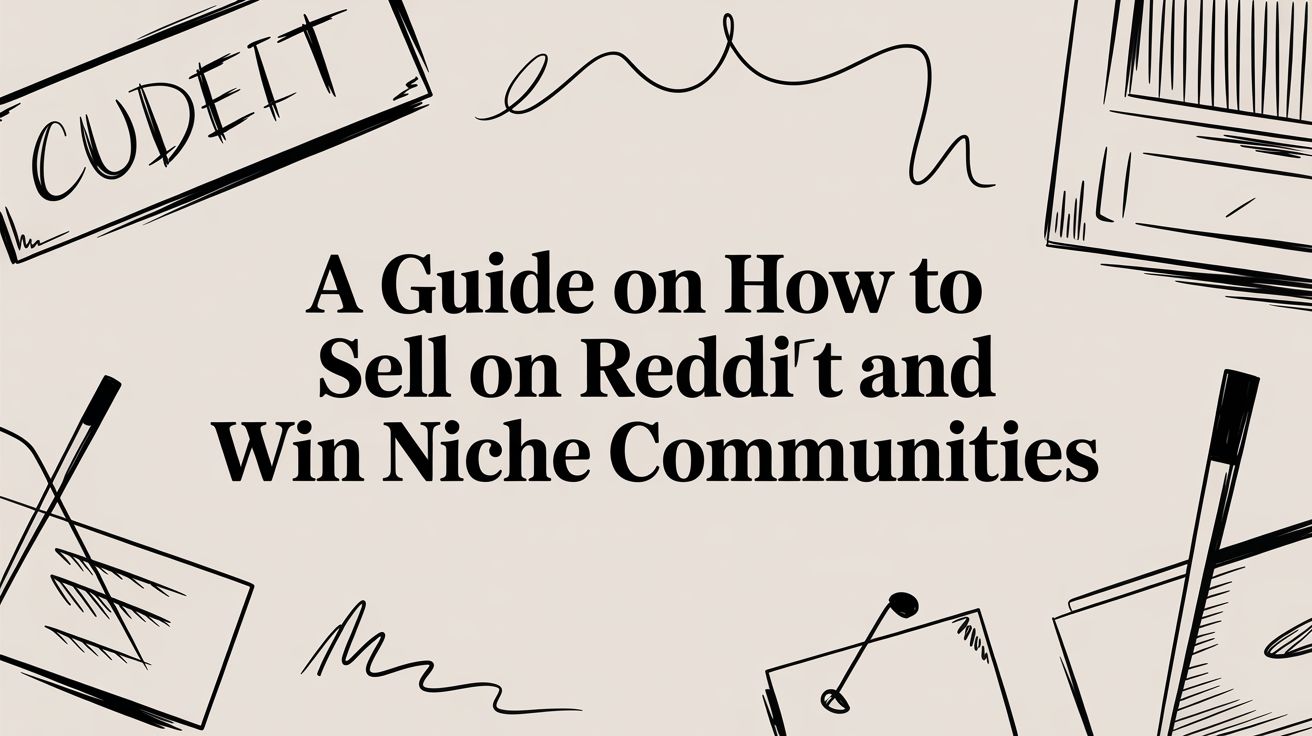A b2b social media strategy is more than just a content calendar. It’s a complete game plan for using social platforms to hit real business goals—think generating high-quality leads, building unshakeable brand authority, and genuinely connecting with your customers.
This means shifting your mindset away from just broadcasting updates. A truly effective strategy turns social media from a megaphone into a powerful engine for business growth by focusing on valuable, human-to-human interactions.
Moving Beyond Likes and Shares
Let’s be honest: the old “post and pray” approach is dead. The B2B social media world has changed, and it's not going back. Simply pushing out company news and expecting results just doesn't cut it anymore. Today's decision-makers are drowning in noise; they're looking for partners and experts who can help them solve their biggest challenges, not just another sales pitch.
This new landscape requires a sharp turn away from chasing vanity metrics like likes and shares. Instead, the focus has to be on cultivating a genuine community and driving outcomes you can actually measure. A modern b2b social media strategy isn’t about shouting louder; it’s about listening intently, engaging thoughtfully, and building real relationships.
The Evolution from Broadcasting to Building
The B2B buyer's journey has become a winding, complex road. A staggering 84% of B2B buyers now lean on social media to guide their purchasing decisions. Long before they ever think about contacting a sales rep, they’re on platforms like LinkedIn, researching solutions, checking out vendors, and seeing what their peers have to say.
This means your social media presence is often your first handshake. If you’re still stuck in broadcast mode—only posting about your company—you’re missing the entire conversation. A winning strategy meets buyers where they are by focusing on what truly matters:
- Establishing Authority: Don't just sell. Solve. Consistently share insights that tackle your audience’s real-world pain points. This positions you as the go-to expert they can’t afford to ignore.
- Humanizing Your Brand: People buy from people. Put a face to your brand by showcasing the experts and leaders behind the logo. It builds the trust and relatability that promotional content never can.
- Fostering Dialogue: Jump into relevant industry conversations. Respond to comments thoughtfully. Create a space for discussion, and you’ll build a loyal community, not just a passive audience.
This chart illustrates that critical shift from simply pushing out a message to strategically building relationships that lead to real business.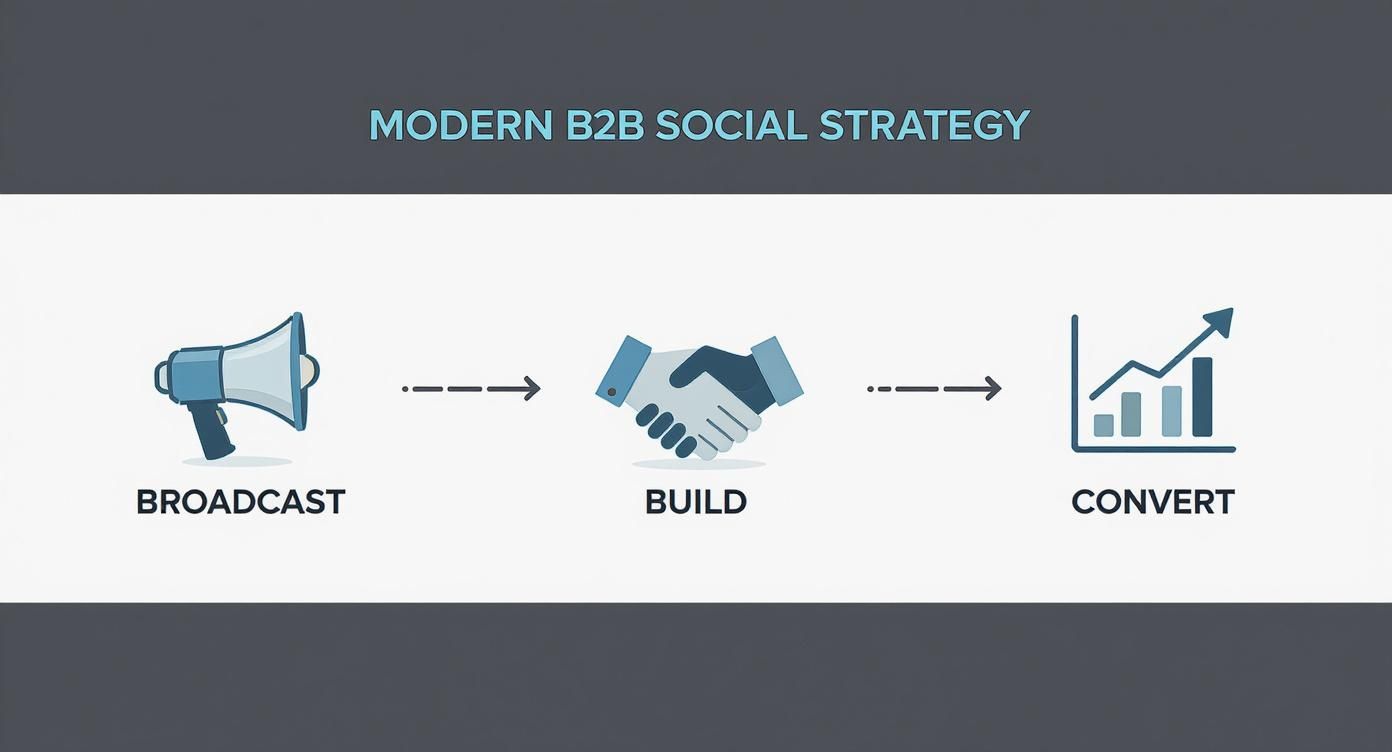
The takeaway is simple but powerful: conversions don't come from broadcasting alone. They’re the natural result of a deliberate, relationship-focused building process.
Aligning Social Strategy with Business Goals
Your social media activity can't operate in a vacuum. To justify the time and budget, every action you take must tie directly back to bigger business objectives. Otherwise, you’re just making noise.
A great social media strategy is a business strategy first. It answers the question, "How can we use these platforms to help the company grow?" not just "What should we post today?"
Start by mapping your social efforts to concrete goals. Are you trying to feed more qualified leads to the sales team? Do you need to build brand credibility to enter a new market? Or is the primary goal to boost customer retention by building a stronger support community?
Each of these goals demands a different playbook—different tactics, content types, and KPIs. To dig deeper into this alignment, you can learn more about how to optimize your B2B social media strategy. This initial step is non-negotiable; it ensures every post, comment, and campaign serves a clear purpose and turns your social channels into a legitimate asset for growth.
Defining Your Goals, Audience, and Platforms
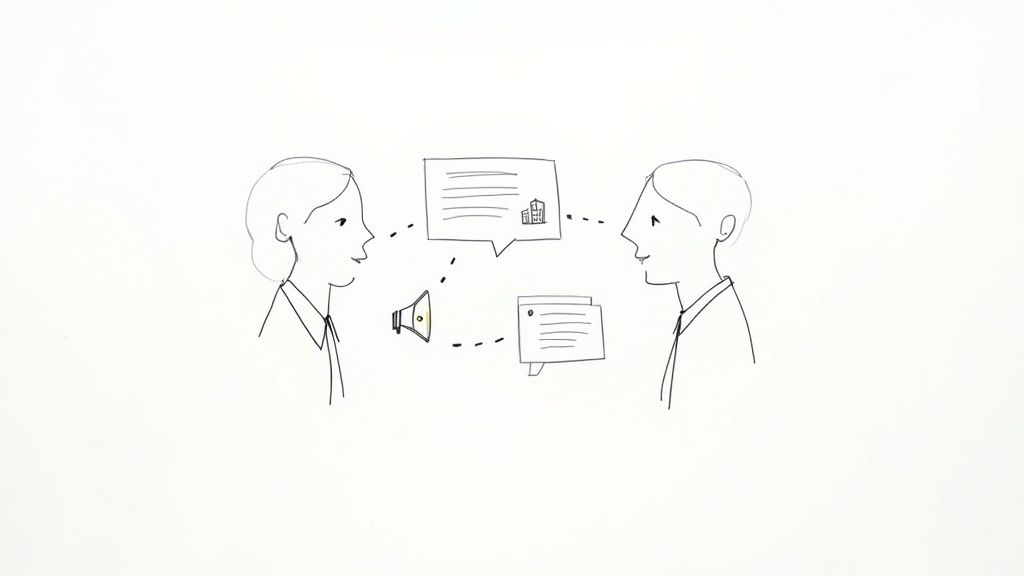
Jumping into social media without a clear direction is a surefire way to waste time and money. A truly effective B2B social media strategy doesn't start with posting—it starts with planning. Before you even think about content, you need to lock down three things: what you're trying to achieve, who you're talking to, and where those conversations are happening.
This initial groundwork is what separates the strategies that drive real business growth from those that just add to the online noise.
Forget vague goals like "getting more followers." To make your efforts count, you need specific, measurable, and time-bound objectives that directly support your bigger business ambitions, like shortening the sales cycle or breaking into a new market.
Instead of chasing vanity metrics, anchor your goals to outcomes that actually impact the bottom line. A great goal sounds less like "grow our audience" and more like "Generate 50 marketing qualified leads (MQLs) from LinkedIn within Q3" or "Increase referral traffic from social media to our pricing page by 20% in the next six months." Targets like these give you a clear destination and a benchmark for success.
Who Are You Actually Talking To?
Once you know what you want to accomplish, you need to get crystal clear on who you're talking to. In B2B, you aren't selling to a faceless corporation; you're connecting with real people who have specific roles, challenges, and motivations. This is where building out detailed buyer personas is non-negotiable.
A solid B2B buyer persona goes way beyond basic demographics. It should paint a vivid picture of the key decision-makers and influencers you need to reach. To get there, ask yourself questions like:
- What’s their actual job title and what are their day-to-day responsibilities?
- What are their biggest professional headaches and daily frustrations?
- Where do they hang out online to find industry news or learn new skills?
- What kind of content would genuinely help them do their job better?
For example, a B2B SaaS company might create a persona for "Operations Olivia," a Director of Operations at a mid-sized logistics firm. We know she's measured on efficiency, gets bogged down by outdated manual processes, and follows supply chain thought leaders on LinkedIn to find smarter solutions. That level of detail is gold—it lets you tailor every message and piece of content to resonate with her specific world.
Choosing Your Battleground: Selecting the Right B2B Platforms
With a clear picture of your audience in mind, you can finally decide where to invest your energy. The goal isn't to be everywhere. It's to be great where it matters most—where your ideal customers are already spending their time.
For the vast majority of B2B companies, one platform stands out. LinkedIn is the undisputed king of B2B social media. It’s not even close. In fact, 68% of B2B marketers have increased their LinkedIn usage, and a massive 85% rate it as their most effective social channel.
Its power for lead generation is particularly impressive, with 62% of marketers saying it delivers leads at twice the rate of any other social platform. You can dig into even more B2B marketing statistics to see the full picture.
Your platform choice should be a strategic decision, not a default one. Focus your energy on mastering one or two channels where your audience is most engaged rather than spreading your efforts too thin across multiple platforms with minimal impact.
Choosing the right channels is all about matching the platform’s strengths to your audience’s habits. The table below breaks down the top contenders.
B2B Social Media Channel Selection Framework
| Platform | Primary B2B Use Case | Ideal Audience | Best Content Formats |
|---|---|---|---|
| Lead generation, thought leadership, professional networking, employer branding | B2B professionals, decision-makers, industry experts, job seekers | Articles, text/image posts, video, case studies, polls, live events | |
| X (Twitter) | Real-time news, customer service, event promotion, community building | Tech professionals, journalists, industry commentators, event attendees | Short-form text, threads, images, video clips, polls, Spaces |
| YouTube | Product demos, tutorials, case studies, educational content, brand storytelling | Visual learners, technical buyers, researchers looking for in-depth information | How-to videos, webinars, customer testimonials, behind-the-scenes content |
| Top-of-funnel brand awareness, community building (via Groups), targeted advertising | Niche B2C-leaning B2B, local businesses, industries with strong communities | Video, live streams, user-generated content, event pages, targeted ads |
While LinkedIn is the obvious starting point for most, don't dismiss other channels that could play a crucial supporting role. A manufacturing firm might use YouTube to post detailed machinery demos, while a design agency could use Instagram to showcase its portfolio and attract creative talent. The key is to be strategic, ensuring every platform you use directly serves your goals and connects you with the people who matter most to your business.
Building a Sustainable Content Engine
https://www.youtube.com/embed/njdx3DKstY0
Alright, you’ve nailed down your goals and have a solid picture of your audience. Now comes the fun part: building the engine that's going to power your entire social media presence. I'm talking about your content.
This isn't about just randomly filling a calendar with posts. It's about creating a steady, sustainable flow of genuinely valuable material that cements your status as an industry leader and keeps your audience hooked. Sporadic updates and generic company news just create noise. To build real traction, you need a system—a proactive, pillar-based plan that turns out great content without driving your team into the ground.
Establish Your Core Content Pillars
Think of content pillars as the foundational themes your brand is going to own. These aren't just random blog ideas. They are three to five core topics that live at the sweet spot where your audience's biggest headaches meet your company's unique expertise. They become the strategic filter for every single thing you create.
Let's say you're a cybersecurity SaaS firm. Your pillars might look something like this:
- Threat Intelligence: Deep dives into new cyber threats and, more importantly, how to stop them.
- Compliance and Governance: Real-world advice on navigating the alphabet soup of regulations like GDPR or HIPAA.
- Cloud Security Best Practices: Practical, no-fluff guides for locking down cloud infrastructure.
See how that works? Every post, video, and article reinforces your authority in these specific, high-value areas. This keeps your messaging tight and makes content creation way more efficient because you’re not staring at a blank page every morning. For more inspiration, it's worth checking out different content marketing strategy examples to see how others structure their pillars.
The whole B2B social media world is shifting toward this kind of authentic, story-driven approach. Marketers are finally ditching the stuffy corporate jargon for a more human tone, which makes sense when you learn that 84% of B2B buyers use social media to inform their purchasing decisions.
Master the Art of Repurposing
Here's the secret to a content engine that doesn't quit: you don't need more content, you need to be smarter with the content you have. One big, high-value asset—like a webinar or a detailed report—can be sliced and diced into dozens of social media posts. This is how you maximize your investment and your reach.
Your best content shouldn't be a one-and-done deal. Treat it like a goldmine. You can excavate valuable nuggets from it and share them in different formats for weeks or even months.
Imagine you just hosted an amazing webinar. That single piece of content can fuel your calendar by becoming:
- A series of short video clips for LinkedIn and YouTube Shorts, each one a punchy takeaway.
- An insightful blog post that summarizes the key points—a cornerstone of any good organic social media marketing plan.
- A slick carousel post for LinkedIn with pull quotes and standout stats from the presentation.
- A text-based thread for X (Twitter) that breaks down a complex idea into bite-sized tips.
- An infographic that makes your data and frameworks easy to understand at a glance.
This "create once, distribute many" model ensures you get maximum mileage from your best work, keeping your feed full of quality material that all stems from a single source of truth.
Create a Realistic Publishing Cadence
Consistency beats frequency, every single time. One of the biggest mistakes I see B2B brands make is coming out of the gate with a super ambitious posting schedule—multiple times a day—only to burn out and go silent for weeks. It's far more effective to post three high-quality, engaging updates per week, every single week, than to post ten times one week and then disappear.
Your publishing cadence should be realistic, based on your team's bandwidth and your audience's habits. Start small and earn the right to get more ambitious. A totally manageable schedule for a B2B brand on LinkedIn could be:
- Monday: A thought leadership piece from one of your executives.
- Wednesday: A short, repurposed video clip from that webinar.
- Friday: A post highlighting a customer success story or a quick case study.
Use a simple content calendar to map this all out. Honestly, a shared spreadsheet works perfectly fine to start. It gives everyone on the team visibility and keeps your content engine humming along, turning your big strategic goals into a reliable stream of social media gold.
Fostering Community and Driving Engagement
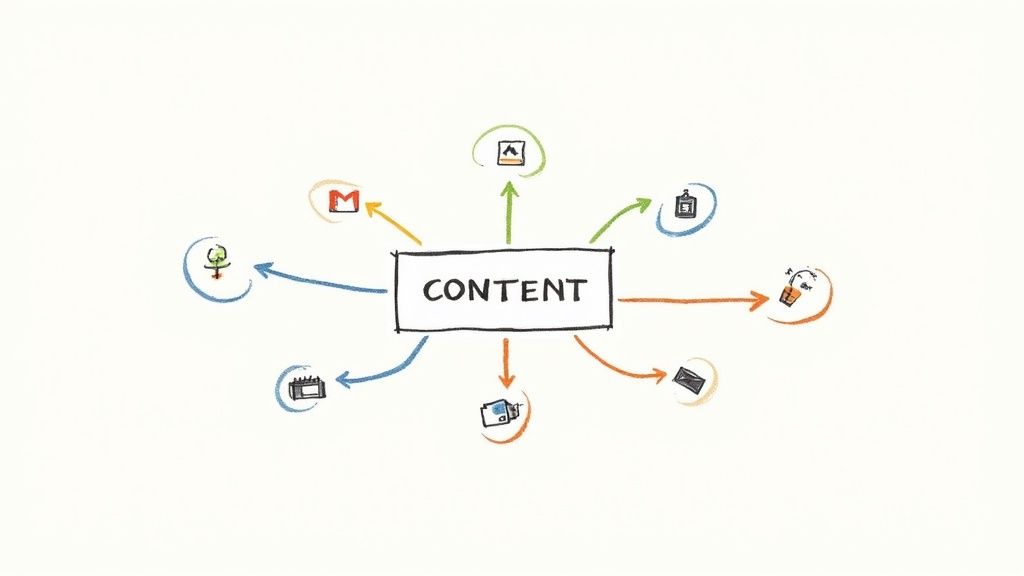
Let's get one thing straight: B2B social media isn't about chasing vanity metrics or shouting your marketing messages into the digital abyss. It's about building a real community. The kind of community where your brand isn't the star of the show, but the host of the party—facilitating great conversations and making valuable introductions.
This means flipping the old script. We need to move away from a "post-first" mentality and adopt a "reply-first" mindset. Your social channels shouldn't be a one-way billboard; they should be the go-to hub for your industry, where people come to learn, share, and connect.
Adopt a Reply-First Playbook
A reply-first playbook is exactly what it sounds like. Your team’s primary job on social media becomes actively participating in conversations that are already happening. This is how you build genuine trust and credibility—something a dozen perfectly crafted promotional posts will never achieve.
Instead of just publishing content and hoping for comments, you go to where your audience is. Your team should be diving into relevant hashtag discussions, engaging with posts from industry leaders, and even monitoring what people are saying in your competitors' comment sections. The goal is never to hijack the conversation, but to add real, tangible value.
A great B2B social media strategy is built on reciprocity. When you give value freely in other people's conversations, they naturally become curious about what you have to say on your own channels.
This kind of proactive engagement is a foundational element for using social media for lead generation. It warms up potential leads by establishing your brand as a helpful, knowledgeable resource long before a sales pitch is ever on the table.
Actively Listen for Opportunities to Add Value
The heart of any solid engagement strategy is social listening. I’m not just talking about tracking brand mentions. I mean listening for chances to be genuinely helpful. Set up alerts for keywords tied to your audience’s biggest headaches, not just your product's name.
What to listen for:
- Questions and frustrations: Find posts where people are asking for advice or venting about a specific problem your company is built to solve.
- Requests for recommendations: Someone asking for a tool or service in your niche? That’s a perfect, low-pressure opening to engage.
- Industry news and trends: Jump into discussions about breaking news with a unique take. This positions your team as forward-thinking experts.
Once you spot an opening, the key is to engage without the hard sell. If a prospect is wrestling with a challenge, don't just drop a link to your pricing page. Share a useful article, tag an expert who might have insight, or offer a quick tip based on your own experience. The philosophy is simple: help first, sell second (if at all).
Empower Your Entire Team to Participate
Your marketing team cannot—and should not—be the only voice of your company online. Think about it: your most credible social media assets are often the engineers, product managers, and customer success folks who live and breathe your industry's challenges every single day. An employee advocacy program isn't just a "nice-to-have"; it's essential for scaling your reach and authenticity.
Encourage your wider team to build their personal brands, especially on platforms like LinkedIn. When a senior developer from your company provides a thoughtful answer to a technical question in a public forum, it carries so much more weight than a generic response from a branded corporate account.
To get this rolling, you need to support them properly:
- Offer Simple Training: Run a quick lunch-and-learn on how to optimize their profiles and engage constructively. Keep it simple and actionable.
- Provide Content Prompts: Create a shared resource (like a Slack channel) where you post company news or interesting industry articles they can easily reshare with their own take.
- Celebrate Their Efforts: Give a shout-out to team members who are doing a great job building community. A little recognition goes a long way.
This approach transforms your B2B social media strategy from a siloed marketing function into a company-wide culture of helpfulness. That’s how you build a brand that people not only follow but truly trust.
Measuring Performance and Optimizing for Growth
A killer B2B social media strategy is only as good as the results it brings in. If you're not measuring what you're doing, you're flying blind. You can't prove your value, and you certainly can't make smart decisions about what to do next. It’s time to stop chasing surface-level vanity metrics and start tying every single social media action back to real business outcomes.
This means we need to shift the conversation away from just likes and shares. The real questions are about website traffic, the quality of leads coming in, and even how social impacts customer acquisition cost (CAC). Your job is to tell a story with data, showing leadership exactly how your work on social is hitting the bottom line.
Connecting Social Activity to Business Outcomes
The first thing you have to do is draw a straight line from a click on a social post to a signed contract. This takes a little technical setup, but it’s the only way to truly prove the ROI of your B2B social media efforts. The simplest, most powerful tool for the job is the UTM parameter.
UTM parameters are just little tags you add to the end of your URLs. They act like breadcrumbs, telling your analytics tools exactly where a visitor came from. A well-tagged link doesn’t just show that someone came from "social media"—it can tell you they came from a specific post on LinkedIn that you published on Tuesday morning.
For instance, a link in a LinkedIn post about a new case study might look something like this:yourwebsite.com/case-study?utm_source=linkedin&utm_medium=social&utm_campaign=q3_casestudy
When you have this kind of tracking integrated with your CRM, you can follow a person’s entire journey. You see the first click on LinkedIn, you see them fill out a demo request on your site, and you see them eventually become a paying customer. This is how you connect the dots between a social media post and actual revenue.
Measuring your B2B social media strategy isn't just about reporting what happened; it's about understanding why it happened so you can make it happen again, but better.
This level of tracking empowers you to answer the questions that matter. You can finally see which platforms are driving not just clicks, but high-quality leads that your sales team can actually close. For some more hands-on advice on this, check out our guide on how to generate B2B leads.
Prioritizing Both Organic and Paid Metrics
To get the full picture, you have to look at both your organic and paid social media performance. They work hand-in-hand, but you need to measure them with slightly different lenses. Paid social, especially, has become an absolute powerhouse for B2B growth.
The money flowing into B2B social media advertising is on track to blow past $256 billion globally. This isn't just wishful thinking; the results are there. A staggering 70% of B2B marketers report a positive ROI from their LinkedIn ads, and 65% of B2B companies have landed new clients directly through paid campaigns on the platform. As the targeting tools get smarter, this channel just gets more efficient. You can dive deeper into these B2B social media trends to see what's on the horizon.
To track everything effectively, you need to match your KPIs to your business goals. Not every metric is created equal.
Here's a quick breakdown of which metrics matter most for some common B2B objectives.
Key B2B Social Media Metrics by Goal
| Business Goal | Primary KPIs | Secondary KPIs |
|---|---|---|
| Brand Awareness | Impressions, Reach, Share of Voice | Follower Growth, Profile Visits, Engagement Rate |
| Lead Generation | Conversions (Form Fills), Cost Per Lead (CPL) | Click-Through Rate (CTR), Website Traffic |
| Thought Leadership | Engagement Rate (Comments/Shares), Mentions | Inbound Link Clicks, Follower Growth |
| Community Building | Comments per Post, User-Generated Content | Audience Growth Rate, Reply Rate |
This simple framework helps you zero in on the numbers that actually show you're making progress toward what matters, making your reporting both meaningful and actionable.
Creating Reports That Tell a Story
All this measurement work comes together in your reports. A great report isn't a data dump. It doesn't just throw a bunch of charts on a slide and call it a day. It tells a story. It needs to clearly show the wins, give context to any challenges, and—most importantly—lay out a clear plan for what you're going to do next.
I like to structure my reports to answer three simple questions for stakeholders:
- What did we achieve? (This is where you show off the primary KPIs and big wins.)
- What did we learn? (Share the insights. Why did something work? Why did that other thing fall flat?)
- What are we doing next? (Lay out your data-backed plan for the next month or quarter.)
When you take this narrative approach, your reports transform from a boring look back into a strategic roadmap for the future. It's how you prove that your B2B social media strategy is a living, breathing part of the company's growth engine.
Common B2B Social Strategy Questions
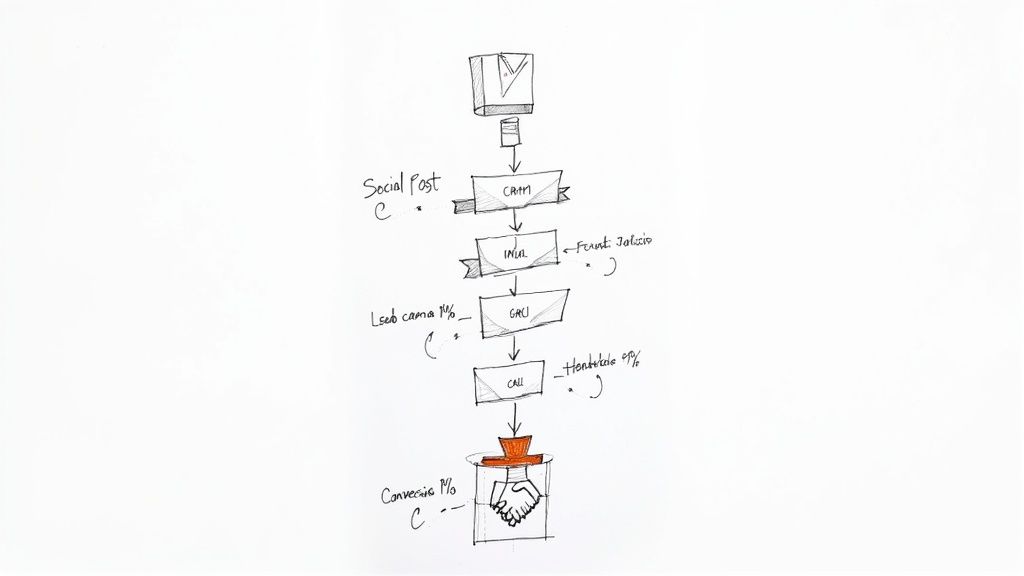
Even with the perfect blueprint, you're going to hit some bumps in the road. In my experience, navigating these common challenges is what separates a strategy that looks great on a slide deck from one that actually moves the needle month after month.
Let's dig into some of the most frequent questions I hear from teams once they start getting serious about their social media efforts.
How Can I Justify Social Media ROI to Leadership?
This is the big one, isn't it? Your executive team doesn't really care about retweets or follower counts. They speak the language of revenue, pipeline, and customer acquisition costs. To get buy-in, you have to meet them there.
The trick is to draw a straight line from your social activity to actual business outcomes. As we’ve discussed, using UTM parameters to track a click from a LinkedIn post all the way to a demo request isn't optional—it's essential. This is how you turn a soft metric like "engagement" into a hard number like, "$50,000 in sales pipeline influenced by social."
Your social media report should stop being a list of what you did. It needs to become a business case that proves how your work contributes to the company's bottom line.
Another powerful tactic is to track what we call "socially-assisted" conversions. A prospect rarely clicks a link and buys on the spot. But your consistent thought leadership on LinkedIn kept you top-of-mind for months. Use your CRM and analytics to show how many of your eventual customers engaged with your social channels before converting somewhere else, like organic search. This paints a far more realistic picture of social media's true influence.
What’s the Right Content Mix with Limited Resources?
Let’s be real: most B2B teams are lean. The thought of churning out an endless stream of original content is enough to cause a panic attack. The answer isn’t to work 80-hour weeks; it's to get smarter about repurposing and curating.
You don't need something brand new every single day. A much more sustainable approach is the "create once, distribute many" model.
- Go big on one cornerstone asset a month. This could be a webinar, a detailed industry report, or an in-depth customer story.
- Slice and dice it relentlessly. That one webinar can be atomized into a dozen different social media assets.
- Lean on third-party content. Share genuinely useful articles and studies from non-competing sources. This positions you as a helpful hub of information and fills the gaps in your content calendar.
Here’s a practical example. Say you produce one 45-minute webinar:
- Week 1: Promote the upcoming event with short video clips from the speaker.
- Week 2: Post the full recording on YouTube and share the link on LinkedIn with key insights.
- Week 3: Turn the main talking points into a slick carousel post and a summary blog article.
- Week 4: Pull out the best quotes from the speaker and create simple, impactful quote graphics to share.
This system gives you a steady stream of high-quality content without the constant grind of starting from a blank page.
How Often Should a B2B Brand Actually Post?
There is no magic number. Anyone who tells you "post X times a day" is just guessing. The right frequency is a cocktail of three ingredients: the platform you're on, your audience's habits, and your team's capacity to produce good content.
Frankly, consistency matters a whole lot more than frequency.
Showing up with three high-value posts every single week is infinitely better than spamming the feed for five days and then going silent for a month. Your audience gets into a rhythm, and the platform's algorithm learns to expect your content. Breaking that rhythm kills your momentum.
As a general starting point for a B2B brand on LinkedIn, aiming for 3-5 quality posts per week is a solid, achievable goal. It’s enough to stay on your audience's radar without drowning them in content or burning out your team. On a faster-moving platform like X (formerly Twitter), you might shoot for 1-2 posts a day.
The only way to know for sure is to test. Start with a manageable schedule, watch your analytics like a hawk, and adjust. If engagement drops when you post more, you’ve found their saturation point. If they're eating up everything you post, you might have room to increase your cadence. Let the data tell you what to do.
Stop chasing conversations and start driving them. Replymer uses real, human-written replies to put your brand in front of the right B2B buyers on Reddit, X, and LinkedIn. See how it works.
